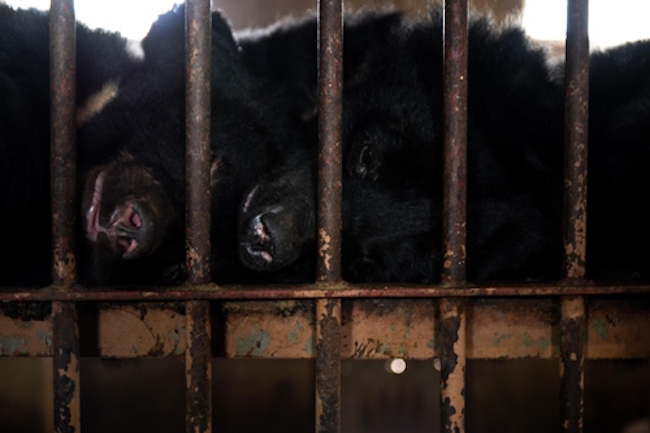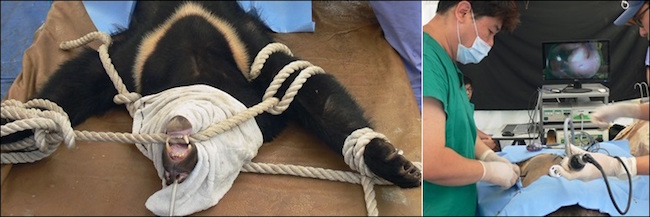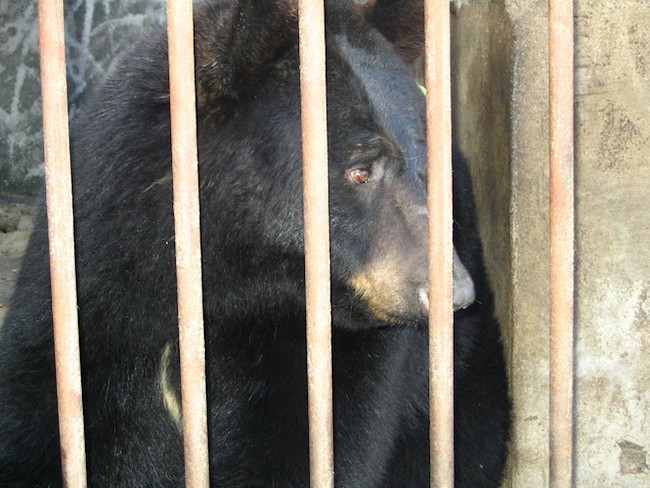
According to environmental group Green Korea, the last vestiges of South Korea’s bear-bile farming industry are surviving in cramped cages, subsisting on insufficient feed and living in their own filth. (Image: Green Korea)
SEOUL, Nov. 21 (Korea Bizwire) – According to environmental group Green Korea, the last vestiges of South Korea’s bear-bile farming industry are surviving in cramped cages, subsisting on insufficient feed and living in their own filth.
Bear-bile farming began in 1981 as a means of generating extra income for the agricultural industry, a practice that was sanctioned by the government. The trade consisted of importing bears and raising them in captivity, with the ultimate purpose of harvesting the bile that is stored in bear’s gallbladders. Bear bile is a commonly found ingredient in many traditional Asian remedies, and the global market for the extract is estimated at $2 billion.
The government reversed its initial support for the bear-bile farming industry in 1985 by banning future imports, bowing to international censure as the Seoul 1988 Summer Olympics loomed. Despite the ban, the population of bears in captivity grew rapidly, surging from 493 imported animals to 1,500 by 2005.

In a move to phase out the practice for good, the government came to an agreement with the industry in 2014 to neuter all bears in captivity, pledging 5.5 billion won in funding. (Image: Korean Animal Welfare Association)
In a move to phase out the practice for good, the government came to an agreement with the industry in 2014 to neuter all bears in captivity, pledging 5.5 billion won in funding. With the exception of 92 bears, 967 underwent the procedure. The law decrees that of these remaining bears, those ten years of age or older can be slaughtered, which would mean the last bear in captivity (born in 2015) would be euthanized by 2024 at the earliest.
However, with three quarters of all “battery bears” over ten years old, many bear-bile farmers have been apathetic in adhering to the law. “The Ministry of Environment said that after the bear born in 2015 passes the 10-year term and is slaughtered, the bear-bile industry will come to an end. However, due to nearly nonexistent demand for bear gallbladders, 75 percent of bears in captivity are over the age of ten,” said Green Korea.
Not only have the bear-bile farmers failed to put the bears out of their misery, neither have they provided even adequate living quarters for the animals. Green Korea pointed out that bears in their natural habitat need at minimum 15 to 20 km of living space, but the battery bears are trapped in small steel cages with barely enough food and horribly unsanitary conditions. The organization criticized the government for pouring “tens of billions of won” into restoring Asian black bears yet turning a blind eye to the plight of bears in captivity that it itself played a significant role in creating.

Besides the brown bear and the American black bear, the remaining six species of bears are classified as either vulnerable or endangered according to the World Conservation Union. (Image: Green Korea)
In response, the Ministry of Environment stated that the responsibility to provide for the bears lies with the farmers and that the government had fulfilled its obligations. “Because of criticism over the conservation of endangered species and animal welfare, the government provided 4.2 million won per bear and completed sterilization of the animals to put a stop to the bear-bile farming industry,” the ministry said.
Besides the brown bear and the American black bear, the remaining six species of bears are classified as either vulnerable or endangered according to the World Conservation Union.
Lina Jang (linajang@koreabizwire.com)






